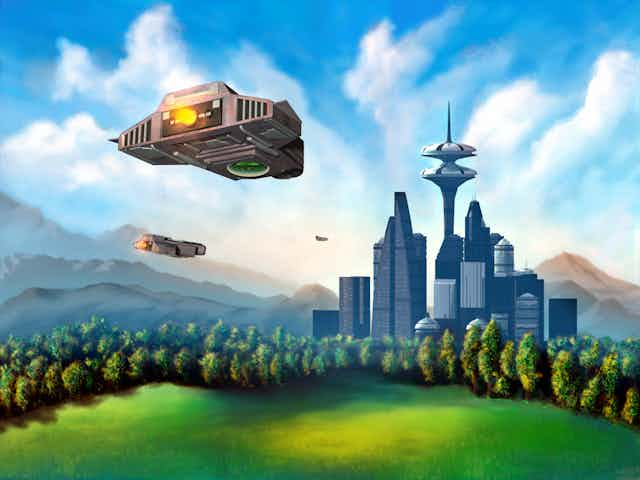Smart cities create a symbiosis between information, the Internet of Things and technologies to make better decisions and provide desired services. These cities map community preferences to improve services and infrastructure including public transport, libraries and waste services. They use sensors, Bluetooth and iPhones to track conditions and activities and send awareness messages ahead of emerging problems and disasters.
Smart cities integrate businesses in an expanding global innovation network. They do much more than creating a single great product or industry to stay ahead of the innovation curve. They develop visioning initiatives to create their preferred futures.
But making products that “change the world” does help keep locations in the news. Hyperloop systems to increase the speed and lower the cost of travel are synonymous with Californian innovators. Augmented reality glasses that will remove the need to work at your PC put New York developers in the spotlight. Singapore is known for its digital economy and driverless taxis.
Smart cities cannot afford to be complacent about their achievements. If they stand still, they will soon be overtaken by further innovation.
Digital disrupter Uber plans to add driverless cars to its ride-sharing network. The next innovative mode of travel around smart cities will be autonomous aerial vehicles – drones and quadcopters. Dubai plans to have passenger drones up and running within months.
How can cities stay ahead of the curve?
For futurist Sohail Inayatullah, progressive innovation is empowering (increasing inclusion), nature-based (learning from, protecting and often enhancing through new technologies) and purposeful.
Mayors, CEOs and leaders create a progressive culture that attracts and retains talented staff. Smart organisations improve staff skills and design reflective spaces. They provide a healthy lifestyle culture supported by excellent pay and conditions.
They also encourage employees to participate in innovation hubs, city labs, maker spaces, universities and business start-ups, and via shared platforms with Creative Commons licences.
California’s high-tech companies – Apple, Facebook, Yahoo, Netflix, eBay, Tesla and the like – gain product feedback from customers and New York financiers every year at CES in Las Vegas. CES 2017 displayed TVs with 2.5mm screens that vibrate to make sound, holographic displays, eye-tracking phones and an electric car that accelerates from 0-59km per hour in 2.39 seconds. While products on display were designed in US cities, global suppliers made many of them.
Cities also stay ahead of the innovation curve through the actions of industry leaders who promote the diversity and stability of local workforces. In 2008, US smart cities benefited from the support of Microsoft founder Bill Gates, who testified to the importance of hiring foreigners.
Microsoft, along with Amazon and Expedia, again supported Washington State in 2017 by testifying against US President Donald Trump’s immigration ban. In a joint message of co-operative governance to protect global relationships, 16 US attorneys-general rallied against the presidential executive order denying entry to citizens from seven Muslim-majority countries. They rejected the immigration ban for undermining national security and America’s core values as a “nation of immigrants”.
Separating reality from hype
Smart city “reality” is about co-creation at the fastest rate in history. This relies on physical and digital connectivity, openness to global markets and high-speed internet. By 2020, Australians will enjoy a 5G wireless internet service with speeds 100 times fast than the current NBN.
High-speed connectivity is needed to support virtual reality and rich entertainment experiences. SpaceX wants to launch 4,425 satellites, rebuilding the internet in space to create a “full and continuous global coverage”.
For leaders, smart city “reality” also means promoting their city’s unique benefits. Socially inclusive, affordable cities with liveable climates attract talented staff.
Australia’s largest city, Sydney, offers those conditions. It is a global leader in bio-tech, high-tech manufacturing. It also has some of the highest levels of sustainability and natural environmental open space in the world.
Compared to London, Sydney rates better for political stability, crime rate, cost of living and cost of rent. Sydney is similar to London in productivity, world university rankings, and health system performance.
Cities with the most advanced technology and liveability include Sydney, London, Stockholm, Seoul and Toronto.
Aligning innovation to emerging futures
Smart cities reduce hype by creating visions. Visioning imagines socially inclusive, sustainable and transformational futures and consequences before enacting them.
When delivering foresight workshops, I use the acronym SELECTFTGP – for “select futures that grow possibilities”. This seeks to encompass all systems: social, environmental, legislative, economic, cultural, technological, futures, transport, governance and political. Considering all social possibilities and impacts, before narrowing to preferred futures, helps to avoid “hype”.
The Australian government has a national Smart Cities Plan. The plan emphasises attraction of talent, accessibility, connecting high-density housing and job centres and high-quality urban design. It recommends a smart city reference group to improve stakeholder engagement, a national cities performance framework, and City Deals.
Queensland is including a Townsville City Deal in its draft regional planning framework, ShapingSEQ. The City Deal will “hard wire” ShapingSEQ through an agreed delivery mechanism for project prioritisation, funding and governance. Submissions on the draft document close March 3, 2017.
Brisbane, Gold Coast, Logan, Sunshine Coast and Geelong have applied futures studies methods to their city visioning.
Smart cities will advance across the Australian landscape when state governments legislate for cities to create and align 20-to-30-year visions to their emerging futures.

